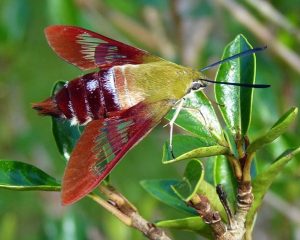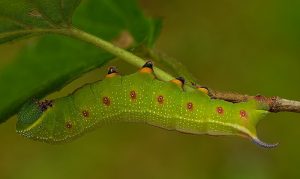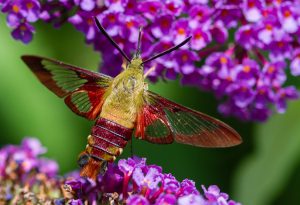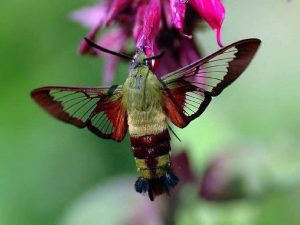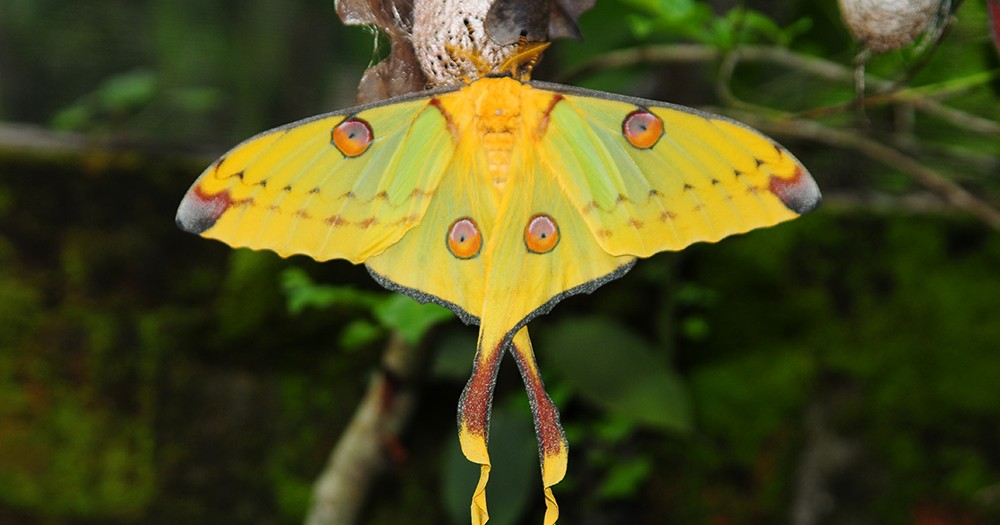Hummingbird Clearwing Moth (Hemaris thysbe)
Hummingbird clearwing moth of the hawkmoth family has an extensive range, spreading to the whole of North America. It comes in a wide range of colors, closely similar to the bumblebee and hummingbird in appearance and behavior.
birdsandblooms.com
Scientific Classification
- Family: Sphingidae
- Genus: Hemaris
- Scientific Name: Hemaris thysbe
Description and Identification
Caterpillar
The larvae have a yellowish-green color with dark green, dark brown, or reddish-brown lines running through their body. A white horn is seen to protrude from the posterior end. Its primary food source includes dogbane, snowberry, honeysuckle, cherry, and several fruit tree varieties.
Pupa
The pupae are brown-colored, having a hard shell, from which the adults emerge in late spring between May and June.
Adult Moth
Sexual Dimorphism: Present
Though they mostly have thread-like antennae, the males of this species could possess bipectinate or comb-like ones.
Color and Appearance
After maturing into adults, their wings are initially reddish or completely black. However, after they take their first flight, most of the scales falls off, making the wings appear transparent with a reddish or brown border when opened. When closed, the pattern remains the same.
Overall, they have an olive green or burgundy back with yellow or white patches on the undersides. The antennae look thick near the base and curved towards the end.
Average Wingspan: 4 – 5.5 cm
Flight Pattern: Consistent
Season: North: April – August; South: March – June; August – September
Eggs
The eggs are a little flattened or rounded, with a translucent green coloration, laid on the leaves’ undersides.
Quick Facts
| Other Names | Clearwing sphinx moth, hummingbird sphinx moth |
| Distribution | Major parts of North America from Alaska up to Oregon (West) and Newfoundland to Florida (east) |
| Habitat | Flower gardens, forest edges, meadows |
| Predators | Beetles, turtles, squirrel, birds, spiders |
| Lifespan of Adults | Not recorded |
| Host Plants | Dogbane, honeysuckle, hawthorn, cherry, snowberry, European cranberry bush, and plum |
| Adult Diet | Nectar of cranberry, snowberry, blueberry, Japanese honeysuckle, thistle, phlox |
Did You Know
- Danish zoologist Johan Christian Fabricius described it for the first time in 1775.
- The slender clearwing and snowberry clearwing have stripes on their thorax and leg’s undersides absent in this species. This is one of the main distinguishing factors between this and the other species.
- Its species name Thisbe is given about Ovid’s Thisbe with the latter’s blood-stained scarf alluding to the flower’s reddish-brown color.
- Though a flower pollinator, it isn’t a pest, not causing severe harm.
- It prefers purple and pink flowers, moving at a fast pace, often mimicking a hummingbird.
Scientific Classification
- Family: Sphingidae
- Genus: Hemaris
- Scientific Name: Hemaris thysbe

